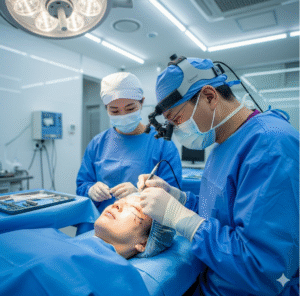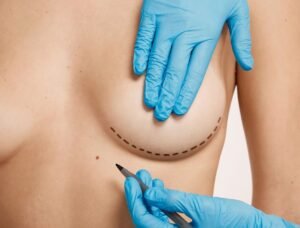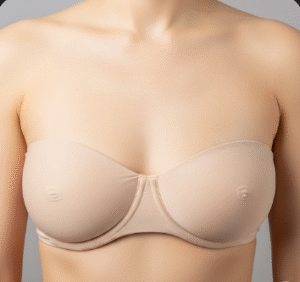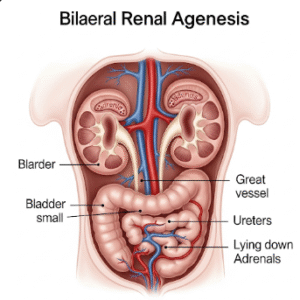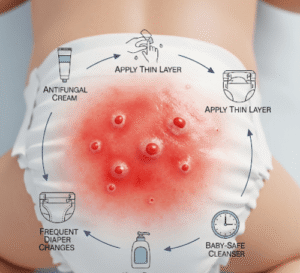A novel topical therapy for precancerous skin lesions
What it is
Actinic keratosis (AK) is a precancerous skin condition caused by long-term sun exposure. It presents as rough, scaly patches on sun-exposed areas such as the face, scalp, ears, forearms, and hands. While often asymptomatic, AK can progress to squamous cell carcinoma (SCC) if untreated.
Tirbanibulin is a new topical microtubule inhibitor approved for the treatment of AK. It works by disrupting microtubule formation in abnormal keratinocytes and inducing apoptosis, effectively clearing precancerous cells.
The treatment is typically delivered as a 5-day topical course and is recognized for its short duration, targeted action, and favorable safety profile. In Korea, dermatology clinics offer tirbanibulin as part of comprehensive AK management, alongside advanced sun protection and monitoring programs.
Why it’s done
Tirbanibulin is used to treat actinic keratosis for several reasons:
✔ Precancer prevention – Reduces the risk of progression to squamous cell carcinoma.
✔ Effective lesion clearance – Proven to clear visible and subclinical AK lesions.
✔ Cosmetic improvement – Restores smoother skin by reducing roughness and scaling.
✔ Convenient regimen – Only 5 days of application, compared to longer treatments with older topical drugs.
✔ Well tolerated – Lower rates of irritation and side effects compared to traditional topical therapies.
Alternatives
Other therapies for actinic keratosis include:
→ Cryotherapy – Freezing lesions with liquid nitrogen; effective for single lesions.
→ Topical treatments –
- 5-fluorouracil (5-FU) cream (2–4 weeks of use).
- Imiquimod cream (2–3 times per week for several weeks).
- Diclofenac gel (2–3 months of application).
→ Photodynamic therapy (PDT) – Application of a photosensitizer followed by light activation; widely used in Korea.
→ Laser therapy – Ablative or resurfacing lasers remove precancerous layers.
→ Surgical excision – For lesions suspected of invasive SCC.
While effective, many of these alternatives require longer treatment durations or cause significant local irritation. Tirbanibulin offers a shorter, well-tolerated alternative.
Preparation
Before starting tirbanibulin therapy, preparation includes:
➤ Dermatologic evaluation – Confirm diagnosis and rule out invasive squamous cell carcinoma.
➤ Medical history – Review of prior treatments, sun exposure, and immune status.
➤ Photography – Baseline documentation for comparison after therapy.
➤ Skin preparation – Clean and dry the treatment area before application.
➤ Patient education – Instructions about correct application and possible mild skin reactions.
How it’s done
Tirbanibulin treatment follows a simple 5-day protocol.
➔ Application – A thin layer of tirbanibulin ointment (1%) is applied once daily to the affected area.
➔ Treatment area – Limited to a 25 cm² field (e.g., face, scalp, or arm patch).
➔ Duration – Continued for 5 consecutive days.
➔ Post-care – Patients should avoid washing the area for at least 8 hours after application.
➔ Precautions – Avoid contact with eyes, mouth, and open wounds.
➔ Follow-up – Korean clinics often schedule review visits after 4–8 weeks to assess clearance.
Recovery
Recovery with tirbanibulin therapy is usually mild and manageable.
→ Local skin reactions – Redness, scaling, or mild crusting may appear within the treated area.
→ Healing time – Reactions usually resolve within 2–4 weeks after treatment.
→ Cosmetic outcomes – Skin often appears smoother and clearer once healed.
→ No downtime – Most patients continue daily activities without interruption.
Complications
While generally well tolerated, possible side effects include:
✔ Mild redness, flaking, or itching.
✔ Crusting or erosion in sensitive areas.
✔ Hyperpigmentation or hypopigmentation (temporary).
✔ Incomplete clearance – Some patients may require repeat treatment or alternative therapies.
✔ Recurrence – AK lesions may reappear with continued sun exposure.
In Korea, dermatologists manage side effects with supportive skincare and follow-up protocols.
Treatment options in Korea
Korea offers advanced, evidence-based management of actinic keratosis, with tirbanibulin integrated into broader treatment strategies.
➤ Wide availability of tirbanibulin – Offered in specialized dermatology and oncology-focused clinics.
➤ Combination therapy – Tirbanibulin may be paired with cryotherapy or PDT for maximum clearance.
➤ Cosmetic integration – Korean clinics combine AK treatment with pigmentation correction and anti-aging care.
➤ Patient education programs – Emphasis on sun protection with high-SPF Korean sunscreens and lifestyle modifications.
➤ Advanced monitoring – Digital dermoscopy and photography track treatment progress.
➤ Medical tourism readiness – International patients have access to bilingual consultations, treatment scheduling, and structured follow-up.
➤ Research and leadership – Korean dermatologists contribute to clinical studies on tirbanibulin, ensuring protocols are cutting-edge.
By choosing tirbanibulin therapy in Korea, patients gain short, effective treatment, superior cosmetic recovery, and strong preventive support, making it one of the most advanced approaches to managing actinic keratosis.



